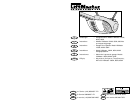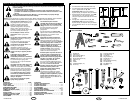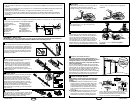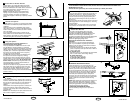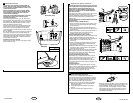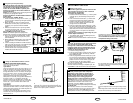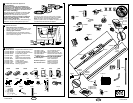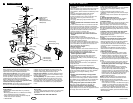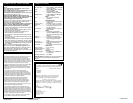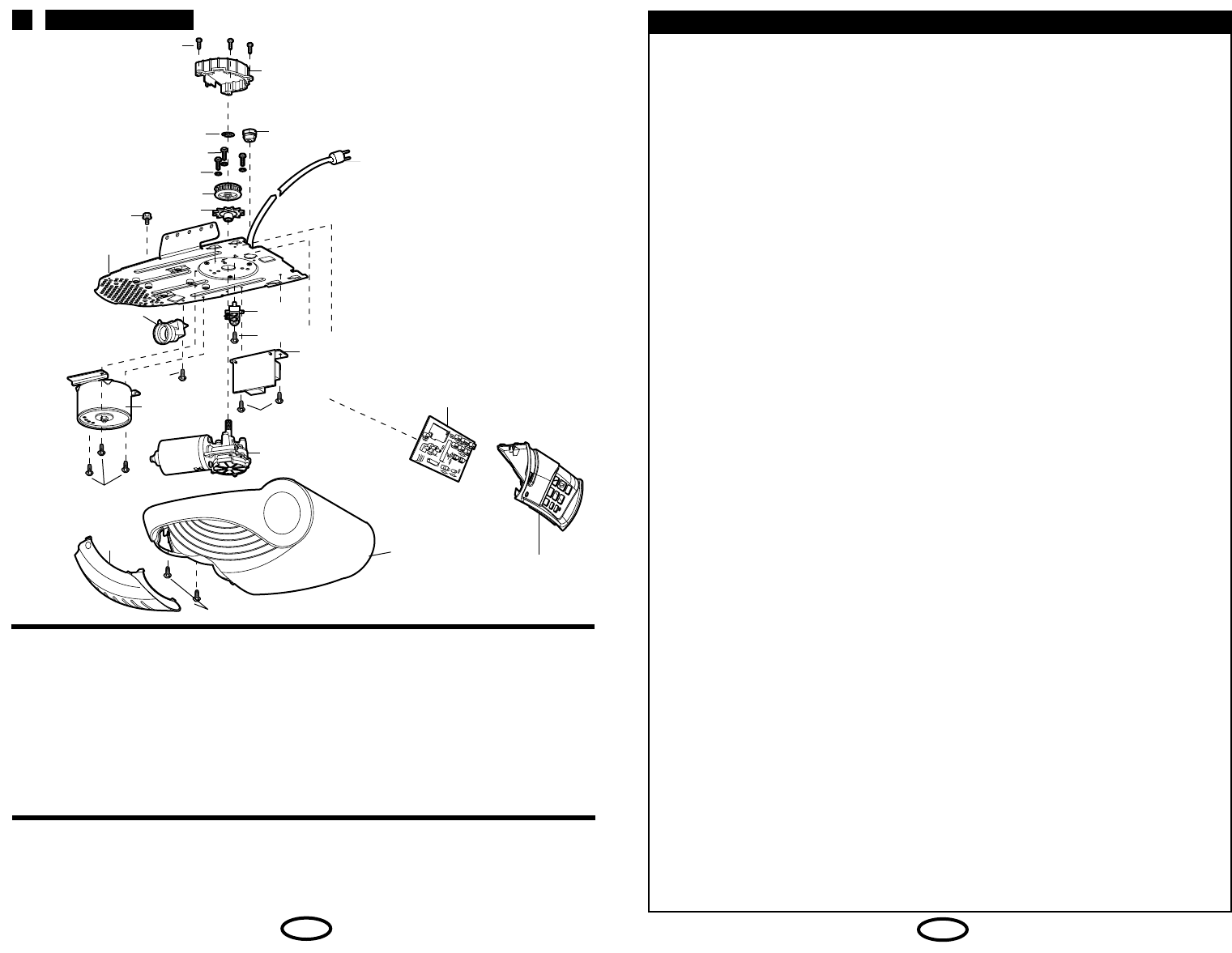
114A2910B-GB
MAINTENANCE OF YOUR OPENER
CARE OF YOUR OPENER
When properly installed, opener will provide high
performance with a minimum of maintenance. The
opener does not require additional lubrication.
Limit and Force Settings: These settings must be
checked and properly set when opener is installed.
Weather conditions may cause some minor changes in
the door operation, requiring some re-adjustments,
particularly during the first year of operation.
Refer to Setting the Limits and Force on page 10.
Follow the instructions carefully and repeat the safety
reverse test after any adjustment.
Remote Control: The remote control may be secured
to a car sun visor with the clip provided. Additional
remotes can be purchased at any time for use in all
vehicles using garage. Refer to Accessories. Any new
remotes must be programmed into the opener.
Remote Control Battery: The lithium batteries should
produce power for up to 5 years. If transmission range
lessens, replace battery .
To Change Battery: To replace batteries, use the visor
clip or screwdriver blade to pry open the case. Insert
batteries positive side up. To replace cover, snap shut
along both sides. Do not dispose of the old battery with
household waste. Take batteries to a proper disposal
center.
Once a Month:
• Repeat safety reverse test. Make any necessary
adjustments.
• Manually operate door. If it is unbalanced or binding,
call for professional garage door service.
• Check to be sure door opens and closes fully. Set
Limits and/or Force if necessary.
Once a Year:
• Oil door rollers, bearings and hinges. The opener does
not require additional lubrication. Do not grease the
door tracks.
• GREASE THE RAIL AND THE TROLLEY.
37D117-2
171A543
158A49
28A95
41B5348
41A5443-5 (60kg)
41A5443-9 (80kg)
41A5443-10 (100kg)
108D56
171A320
41A5696-2b (60kg)
41A5696-4b (80kg, 100kg)
41D163
41D701-2 (60kg)
41D605
(80kg, 100kg)
171A545
171A384-8
171A384
171A315
41B5351-5
41C5392
41B4375-3
26B66-2 (Schuko)
171A498
31D525
216A206
41C67
41C5350-5 (60kg)
41C5350-8 (80kg)
41C5350-2 (100kg)
171A479
26B62-3 (UK)
26B63 (Swiss cord)
26B72 (Australia & China)
26B83 (Danish)
33
13-GB
REPLACEMENT PARTS
114A2910B-GB
14-GB
1. Opener doesn't operate from either door control
or remote:
• Does the opener have electric power? Plug lamp into
outlet. If it doesn't light, check the fuse box or the
circuit breaker. (Some outlets are controlled by a wall
switch.)
• Have you disengaged all door locks? Review
installation instruction warnings on page 1.
• Is there a build-up of ice or snow under door? The
door may be frozen to ground. Remove any
obstruction.
• The garage door spring may be broken. Have it
replaced.
2. Opener operates from remote but not from door
control:
• Is door control button lit? If not, remove the bell wire
from the opener terminals. Short the red and white
terminals by touching both terminals at the same time
with a piece of wire. If the opener runs, check for a
faulty wire connection at the door control, a short
under the staples, or a broken wire.
• Are wiring connections correct? Review page 7.
3. Door operates from door control but not from
remote:
• Replace battery if necessary.
• If you have two or more remotes and only one
operates, review Program Your Opener, Remote and
Keyless Entry steps 22 and 24.
• Is the door control button flashing? The opener is in
lock mode. If you have a Multi-Function Door Control,
push and hold the Lock button for 2 seconds. The
door control button will stop flashing.
4. Remote has short range:
• Is battery installed?
• Change the location of the remote control on the car.
• A metal garage door, foil-backed insulation or metal
siding will reduce the transmission range.
5. Door reverses for no apparent reason and
opener light doesn't blink:
• Is something obstructing the door? Pull manual
release handle. Operate door manually. If it is
unbalanced or binding, call for professional garage
door service.
• Clear any ice or snow from garage floor area where
garage door closes.
• Repeat Setting Limits and Force, see adjustment
steps 26 and 27.
Repeat safety reverse test after adjustment is
complete.
6. Door reverses for no apparent reason and
opener light blinks for 5 seconds after reversing:
Check The Protector System™ (if you have installed
this accessory). If the light is blinking, correct
alignment.
7. Opener noise is disturbing in living quarters
of home:
If operational noise is a problem because of proximity
of the opener to the living quarters, Vibration Isolator
Kit 41A3263 can be installed. This kit was designed to
reduce the "sounding board effect" and is easy to
install.
8. The garage door opens and closes by itself:
Make sure remote push button is not stuck "on".
9. Door stops but doesn't close completely:
Repeat Setting the Limits, see adjustment step 26.
Repeat safety reverse test after any adjustment of door
arm length, close force or down limit.
10. Door opens but won't close:
• Check The Protector System™ (if you have installed
this accessory). If the light is blinking, correct
alignment.
• If opener light does not blink and it is a new
installation, repeat Setting the Limit and Force steps
26 and 27.
Repeat the safety reverse test after the adjustment is
complete.
11. Opener light does not turn on:
Replace light bulb (230V/40W maximum). Replace
burned out bulbs with rough service light bulbs.
12. Opener strains:
Door may be unbalanced or springs are broken. Close
door and use manual release rope and handle to
disconnect trolley. Open and close door manually. A
properly balanced door will stay in any point of travel
while being supported entirely by its springs. If it does
not, call for professional garage door service to correct
the problem.
13. Opener motor hums briefly, then won't work:
• Garage door springs are broken. SEE ABOVE.
• If problem occurs on first operation of opener, door is
locked. Disable door lock.
Repeat safety reverse test after adjustment is
complete.
14. Opener won't activate due to power failure:
• Pull manual release rope and handle down to
disconnect trolley. Door can be opened and closed
manually. When the power is restored, pull the
manual release handle down and toward opener. The
next time the opener is activated, the trolley will
reconnect.
• The Outside Quick Release accessory (if fitted)
disconnects the trolley from outside the garage in
case of power failure.
15. Setting the limits manually:
1. Press and hold the black button until the yellow
indicator light starts flashing slowly then release.
2. Adjust the position of the door by using the black
and orange buttons. Black moves the door UP
(open) and orange moves the door DOWN (close).
Check to be sure the door opens high enough for your
vehicle.
3. Push the remote control or door control. This sets
the UP (open) limit and begins closing the door.
Immediately press either the orange or the black
button. The door will stop.
Adjust the desired DOWN (close) limit position
using the black and orange buttons. Check to be
sure the door is fully closed without applying
excessive pressure on the rail (rail should not bow
upwards and the chain/belt should not sag or droop
below the rail). Push the remote control or door
control. This sets the DOWN (close) limit and
begins opening the door.
NOTE: If neither the black or the orange button is
pressed, the door will reverse off the floor and the
DOWN travel limit will be set automatically.
4. Open and close the door with the remote control or
door control 2 or 3 times.
• If the door does not stop in the desired UP (open)
position or reverses before the door stops at the
DOWN (close) position, repeat Setting the Limits
and Force, see adjustment steps 26 and 27.
• If the door stops in both the desired UP (open) and
DOWN (close) positions, proceed to Test the Safety
Reversal System.
HAVING A PROBLEM?



